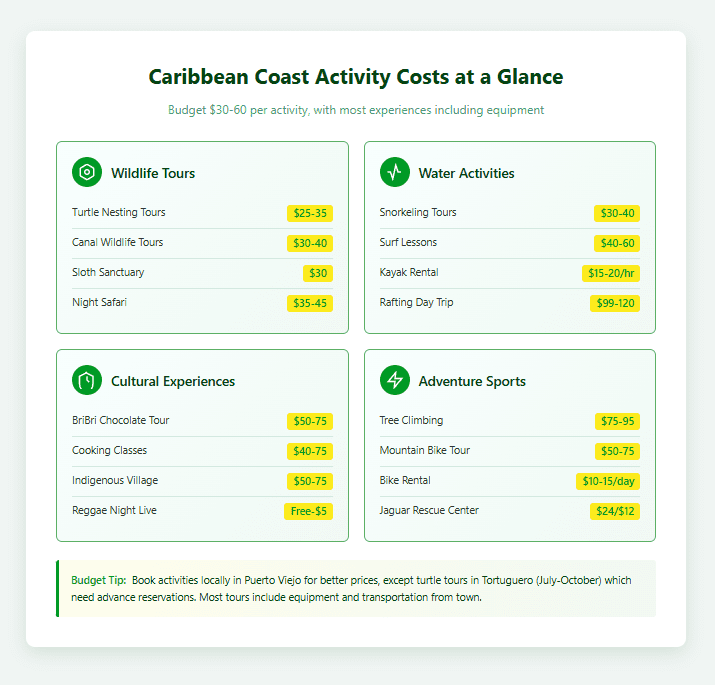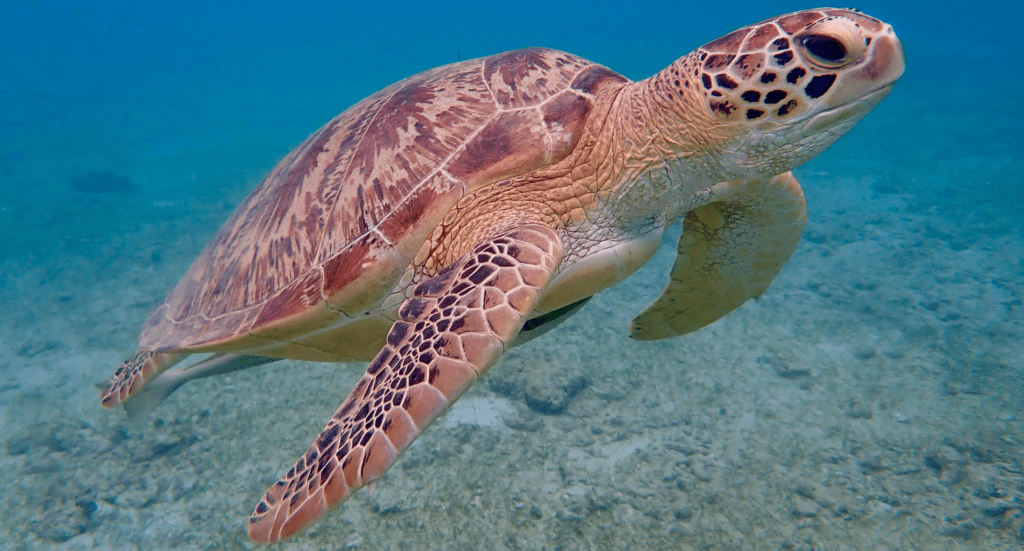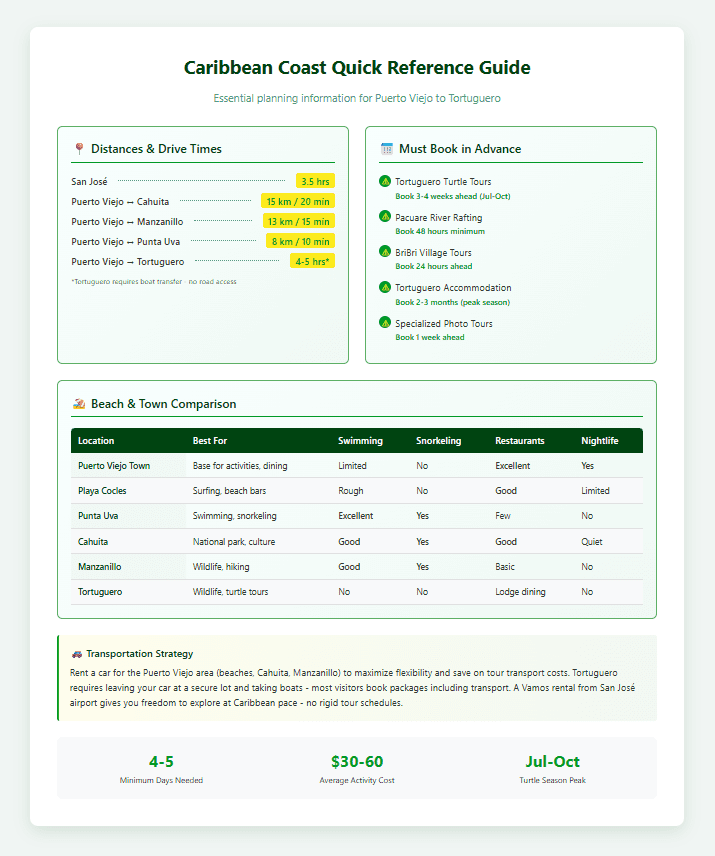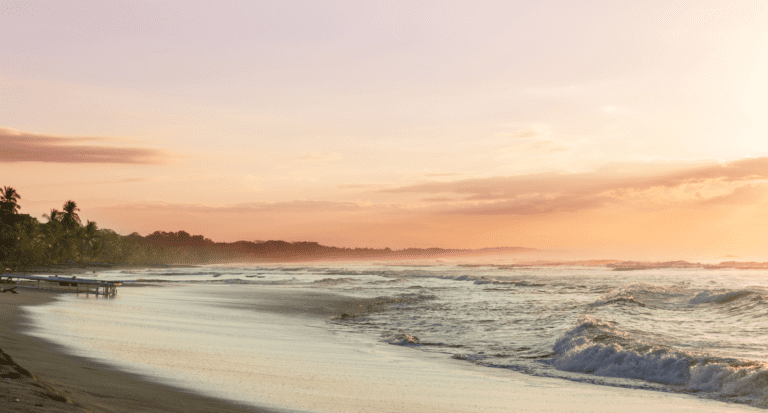Caribbean Coast Activities: What's Covered
Costa Rica’s Caribbean coast delivers experiences you won’t find on the Pacific side – from Tortuguero’s turtle nesting beaches to Puerto Viejo’s legendary surf breaks and Afro-Caribbean culture. Activities range from snorkeling Cahuita’s coral reefs ($30-40) to BriBri chocolate tours ($50-75), with most experiences between Puerto Viejo and Tortuguero requiring 4-5 days minimum. Having a rental car from San José or Liberia airports provides flexibility to explore remote beaches without depending on limited bus schedules.
Quick Facts:
- Peak turtle nesting runs July-October at Tortuguero ($25-35 night tours)
- Water activities work best September-November (calm seas, clear visibility)
- Salsa Brava surf break demands advanced skills (December-March)
- Most activities cost $30-60, advance booking needed for turtle tours
- Puerto Viejo base gives access to beaches, culture, and water sports
Top Caribbean Coast Experiences:
- Tortuguero Canal Tours – Morning boat trips ($30-40) spot caimans, sloths, and 300+ bird species in waterways inaccessible by road.
- Cahuita Snorkeling – Protected reef with 35 coral species and 123 fish species, clearest September-November.
- BriBri Chocolate Tours – Indigenous communities share traditional cacao processing and rainforest knowledge ($50-75).
- Pacuare River Rafting – World-class Class III-IV rapids through pristine rainforest gorges ($99-120).
- Salsa Brava Surfing – Costa Rica’s most powerful wave breaking over shallow reef, experts only.
A rental vehicle unlocks the Caribbean’s best experiences – from dawn wildlife watching to spontaneous beach stops where shuttle services don’t reach.
If you need any help with a Costa Rica car rental, contact us now!
Costa Rica’s Caribbean coast serves up a completely different experience from the Pacific side – think Afro-Caribbean culture, pristine coral reefs, and turtle nesting beaches rather than all-inclusive resorts and tourist crowds. From Puerto Viejo to Tortuguero, you’re looking at roughly 200 kilometers of coastline where activities range from adrenaline-pumping surf sessions at Salsa Brava to peaceful wildlife watching in Tortuguero’s canals, with everything from chocolate tours to reggae nights filling the spaces between.
The real draw here isn’t just the activities themselves – it’s how they connect you to a side of Costa Rica most visitors miss. You’ll find yourself learning to make Caribbean-style rice and beans from someone’s grandmother, spotting sloths from your breakfast table, or watching hundreds of baby turtles scramble toward the ocean under moonlight.
Key Takeaways
- Best wildlife viewing: Tortuguero for turtle nesting (July-October), Cahuita and Puerto Viejo for year-round sloth spotting
- Water activities: Snorkeling at Cahuita’s reef ($30-40), surfing Salsa Brava (December-March), kayaking Tortuguero canals ($15/hour)
- Cultural experiences: BriBri chocolate tours ($50-75), Afro-Caribbean cooking classes ($40-75), reggae nights in Puerto Viejo
- Adventure options: Pacuare River rafting ($99-120), tree climbing ($75-95), mountain biking coastal trails
- Planning essentials: 4-5 days minimum, advance booking for turtle tours, rental car recommended for flexibility
- Budget range: Activities cost $15-120, with most experiences between $30-60

What Makes Caribbean Coast Activities Worth Your Time?
The Caribbean side operates differently from Costa Rica’s Pacific coast. While Guanacaste runs on tourist time with scheduled tours and resort packages, the Caribbean moves to local rhythms where the best experiences often happen spontaneously.
Activities here blend natural encounters with cultural immersion in ways you won’t find elsewhere in Costa Rica. A chocolate tour becomes a lesson in indigenous farming practices. A cooking class turns into stories about Jamaican immigration. Even a simple beach day might include impromptu drumming sessions or conversations with local fishermen about the morning’s catch.
Which Wildlife Experiences Should You Prioritize?
Where Can You Actually See Sea Turtles Nesting?
Tortuguero National Park hosts one of the world’s most important green turtle nesting sites, with peak activity from July through October. Night tours ($25-35) run from 8 PM to midnight with groups limited to 10 people per guide. You’ll walk dark beaches using only red lights, potentially covering 2-3 kilometers before encountering nesting females.
The Gandoca-Manzanillo Refuge offers a more intimate experience from February to July with leatherback, hawksbill, and green turtles. Being less visited than Tortuguero means smaller crowds but also fewer guaranteed sightings.
When Do Sloths and Monkeys Actually Show Themselves?
Sloths hang around Puerto Viejo, Cahuita, and Punta Uva year-round, most visible in cecropia trees during morning hours (6-9 AM) when they occasionally move between branches. The Sloth Sanctuary near Cahuita ($30 adults) provides educational tours where orphaned babies in rehabilitation offer guaranteed sightings.
Howler monkeys wake you up anywhere from Manzanillo to Tortuguero with their deep roars starting around 5:30 AM. White-faced capuchins actively forage throughout Cahuita National Park and around Punta Uva during early morning and late afternoon feeding times.
What’s Different About Tortuguero’s Canal Tours?
Morning canal tours (6-9 AM, $30-40) through Tortuguero’s waterways reveal caimans, river turtles, three-toed sloths, and over 300 bird species from the unique vantage of a quiet boat. Night safari trips ($35-45) use spotlights to find caiman eyes glowing red in the darkness, fishing bats skimming the water, and nocturnal birds like potoos perfectly camouflaged on branches.
Kayak rentals ($15-20/hour) let you explore smaller channels where motorboats can’t reach, though you’ll need decent upper body strength to paddle against occasional currents.
Which Water Activities Live Up to the Hype?

Where Should Beginners and Experts Surf?
Salsa Brava in Puerto Viejo produces Costa Rica’s most powerful wave from December through March, breaking over shallow coral reef to create hollow right-hand barrels. This spot demands advanced skills – if you’re not comfortable with overhead waves and shallow reef breaks, stay on the beach.
Playa Cocles offers more forgiving conditions with sandy bottom beach breaks suitable for intermediates and beginners on smaller days. Surf lessons here run $40-60 for two hours including board rental, with Caribbean Surf School providing quality instruction from local surfers who know every break’s personality.
Which Snorkeling Spots Actually Have Fish?
Cahuita National Park protects 35 coral species and 123 fish species accessible via guided tours ($30-40 including equipment) departing from the park entrance. September through November typically offers the clearest water, though morning trips any time of year beat afternoon wind chop.
Punta Uva’s rocky points shelter colorful reef fish visible right from shore when seas stay calm. Bring your own gear or rent in town for $10/day. The southern end of Manzanillo beach features coral formations perfect for independent snorkeling during calm conditions.
How Challenging Is Pacuare River Rafting?
The Pacuare River delivers world-class whitewater through pristine rainforest gorges with Class III-IV rapids that challenge without terrifying. Full-day trips ($99-120) include transportation from Puerto Viejo, professional guides, equipment, and riverside lunch.
December through May brings technical rapids requiring precise navigation, while May through November’s higher water creates bigger waves and faster currents. Multi-day expeditions ($300-450) add riverside eco-lodge stays accessible only by raft.
What Cultural Activities Connect You with Local Life?
How Do Indigenous Community Tours Actually Work?
BriBri communities near Puerto Viejo offer half-day experiences ($50-75) combining traditional chocolate production with insights into rainforest living. You’ll harvest cacao pods, learn fermentation processes, grind beans on stone metates, and understand how indigenous agricultural practices protect biodiversity.
The Kèköldi Indigenous Reserve focuses on iguana conservation while sharing traditional ecological knowledge. The remote Yorkin community requires a dugout canoe journey but rewards adventurous visitors with overnight stays participating in daily activities from medicinal plant walks to traditional cooking.
What Makes Caribbean Cooking Classes Special?
Family-run cooking classes in Cahuita and Puerto Viejo ($40-75) teach you to prepare rondon (coconut seafood stew), rice and beans cooked in coconut milk, and patí (spicy meat pastries) while sharing stories about Afro-Caribbean immigration and food traditions.
Most classes start with market visits or garden harvesting to identify essential ingredients like culantro (stronger than cilantro), Scotch bonnet peppers, and fresh coconut. You’ll learn why Caribbean rice and beans taste completely different from the Central Valley version – it’s all about that coconut milk base.
Where Does Live Music Actually Happen?
Hot Rocks and other Puerto Viejo venues feature live reggae multiple nights weekly starting around 9 PM, with minimal or no cover charges. Saturday nights in Cahuita often include calypso performances by elder musicians keeping traditional stories alive through music.
Beach bars in Playa Cocles host spontaneous jam sessions where traveling musicians mix with local drummers. These unscheduled performances often create the most memorable musical experiences.

Which Adventure Activities Justify the Price?
Professional tree climbing excursions ($75-95) use specialized equipment to ascend 30+ meters into rainforest giants around Cahuita and Puerto Viejo. Unlike ziplines that rush past, climbing provides time for canopy-level wildlife observation and photography from perspectives few visitors experience.
Mountain biking offers both casual coastal cruising and technical rainforest trails. The flat 15-kilometer stretch between Cahuita and Puerto Viejo suits all skill levels with bike rentals at $10-15/day. Experienced riders tackle challenging single-track behind Manzanillo with local guides ($50-75 half-day) who know which trails stay rideable after rain.
How Should You Plan Your Caribbean Coast Schedule?
What Works for a Long Weekend?
Four to five days allows hitting the highlights without exhaustion. Base yourself in Puerto Viejo for easy access to beaches, restaurants, and activities.
Day 1: Explore Puerto Viejo town, surf lesson at Cocles, evening at Hot Rocks Day 2: Early morning sloth spotting, Cahuita National Park snorkeling, BriBri chocolate tour Day 3: Jaguar Rescue Center, Punta Uva beach time, sunset Caribbean cooking class Day 4: Full-day Pacuare rafting or travel to Tortuguero for canal tours
What’s Realistic for a Week?
Seven days lets you experience both Puerto Viejo’s beaches and Tortuguero’s wildlife without rushing. Split your time between two bases to minimize packing and unpacking.
Days 1-4: Puerto Viejo area including Cahuita, Manzanillo, cultural tours, and water activities Day 5: Travel day to Tortuguero with stops en route Days 6-7: Tortuguero canal tours, turtle nesting (in season), village exploration
Having a rental car for the Puerto Viejo portion provides flexibility to explore at your pace – perfect for those sunrise wildlife walks or spontaneous beach stops. Vamos can arrange your pickup at either San José or Liberia airports with vehicles suited for coastal roads.

What Practical Details Make or Break Your Experience?
Which Activities Need Advance Booking?
Tortuguero turtle tours sell out weeks ahead during July-October peak season. Pacuare rafting trips need 48-hour minimum booking. Indigenous community visits require coordination through authorized operators to ensure respectful, beneficial exchanges.
Everything else – surf lessons, snorkeling trips, cooking classes – you can arrange locally based on weather and energy levels.
What Should You Actually Pack?
Quick-dry clothing beats cotton in this humidity. Reef-safe sunscreen protects both you and coral ecosystems. Water shoes with grip handle rocky beaches and slippery trails better than flip-flops.
Bring binoculars (8×42 ideal) for wildlife watching, dry bags for electronics during water activities, and 20-30% DEET insect repellent for forest activities. Most specialized gear like surf boards or snorkel equipment rents locally, but quality varies.
When Do Weather Patterns Affect Activities?
September and October’s “little summer” brings unexpected sunshine when the Pacific floods. December through March delivers the most consistent Caribbean weather with calmer seas for snorkeling and prime surf conditions.
Heavy rains can reduce snorkeling visibility for days, but Tortuguero’s canal tours run regardless of weather – sometimes rain brings out more wildlife.

Your Next Steps for Caribbean Coast Adventures
The Caribbean coast rewards travelers who embrace its rhythms rather than fighting them. Build flexibility into your schedule. Book critical experiences like turtle tours in advance but leave room for spontaneous discoveries.
Start planning by choosing between a Puerto Viejo beach base or including Tortuguero’s wildlife wonderland. Consider how a rental car from Vamos opens up hidden beaches and eliminates the puzzle of connecting local buses. Most importantly, prepare yourself for a completely different Costa Rica experience – one where “island time” isn’t just a saying but a genuinely different approach to life.
For complete Costa Rica planning beyond the Caribbean coast, check out our Planning the Ultimate Costa Rica Vacation guide. And if you’re deciding between airports, our Choosing the Right Costa Rica Airport breakdown helps you pick the best entry point for Caribbean adventures.
The Caribbean coast doesn’t just offer activities – it provides connections to culture, nature, and rhythms of life you won’t find anywhere else in Costa Rica. Pack your sense of adventure, leave your rigid schedule at home, and prepare for experiences that become stories worth telling.
Frequently Asked Questions
What kind of activities do locals enjoy on Costa Rica’s Caribbean coast?
Locals spend weekends at Playa Cocles for surfing and beach soccer, gather for dominos and cold Imperial beers at sodas in Cahuita, and head to Punta Uva for family picnics with fresh ceviche. You’ll find them fishing from the Puerto Viejo pier at dawn, playing pickup basketball in town squares, and dancing to live calypso at community festivals. The Sunday farmer’s market in Puerto Viejo draws crowds for fresh coconut water, homemade patí, and tropical fruits you won’t find anywhere else in Costa Rica.
What can you do on the Caribbean coast that you can’t do on the Pacific side?
The Caribbean offers experiences unique to this coast – witness green turtle nesting at Tortuguero (July-October), surf the legendary Salsa Brava reef break, explore Afro-Caribbean culture through cooking classes and calypso music, and navigate canal systems by boat where roads don’t exist. You’ll snorkel Costa Rica’s largest coral reef system at Cahuita, learn chocolate making from BriBri indigenous communities, and taste rondon stew that’s been simmering in coconut milk for hours. The reggae nightlife, Creole English conversations, and laid-back island vibe simply don’t exist on the Pacific side.
What is the Caribbean coast famous for in Costa Rica?
Costa Rica’s Caribbean coast is known for Tortuguero’s sea turtle nesting beaches (hosting thousands of green turtles annually), the country’s only significant coral reefs, and its distinctive Afro-Caribbean culture brought by Jamaican railroad workers. The region produces most of Costa Rica’s bananas and cacao, features the powerful Salsa Brava surf break, and maintains a more relaxed, less-developed atmosphere than Pacific tourist hubs. It’s where you’ll hear Bob Marley instead of mariachi, eat rice and beans cooked in coconut milk, and find sloths hanging in trees right above the beach.
What are the top 3 must-do activities on the Caribbean coast?
First, take a night turtle tour in Tortuguero between July and October ($25-35) to watch massive green turtles nest on moonlit beaches. Second, snorkel Cahuita National Park’s protected reef ($30-40 with guide) where you’ll spot parrotfish, angelfish, and maybe a nurse shark among 35 coral species. Third, join a BriBri chocolate tour ($50-75) to harvest cacao, learn traditional processing, and understand indigenous connections to this ancient crop. Each offers something you genuinely can’t experience elsewhere in Costa Rica.
Why do tourists prefer Costa Rica’s Caribbean coast over other Caribbean destinations?
Unlike island destinations requiring expensive flights and resorts, Costa Rica’s Caribbean coast combines beach experiences with rainforest adventures, wildlife viewing, and cultural immersion – all accessible by car from San José in 3.5 hours. You’re getting Caribbean beaches plus volcano access, cloud forests, and world-class whitewater rafting within the same country. The region offers better value than most Caribbean islands, with activities costing $30-60 versus $100+ elsewhere, and you don’t need a passport if you’re already exploring Costa Rica.
What’s the safest area to stay on the Caribbean coast?
Cahuita and Puerto Viejo town centers offer the safest accommodations with good lighting, regular foot traffic, and established tourism infrastructure. Hotels like Le Cameleon (4.5 rating) in Cocles and Passion Fruit Lodge (4.6 rating) in Cahuita provide secure parking and 24-hour reception. Avoid isolated beach camping and stick to well-reviewed properties with ratings above 4.4. The communities are generally safe, but standard precautions apply – don’t leave valuables on the beach, avoid walking alone on dark beaches at night, and use hotel safes for passports and cash.
What beach activities work best for families with kids?
Punta Uva offers the calmest swimming conditions with shallow, protected areas perfect for children, plus tide pools to explore at the rocky edges. Rent clear-bottom kayaks ($20/hour) for kids to see fish without getting wet, or join the Jaguar Rescue Center tour ($24 adults/$12 kids) for close-up sloth and monkey viewing. Cahuita National Park’s main trail stays flat and shaded – ideal for family hikes with frequent monkey sightings to keep kids engaged. Most chocolate tours welcome children with hands-on activities like grinding cacao beans and tasting fresh chocolate.
When is the best time to visit the Caribbean coast for water activities?
September through November brings the clearest snorkeling conditions with calm seas and excellent visibility – this is when the Pacific coast gets hammered by rain but the Caribbean enjoys its “little summer.” December through March delivers prime surfing at Salsa Brava with consistent swells and offshore winds. Water temperatures stay warm year-round (27-29°C), so swimming’s always comfortable. Avoid June and July for snorkeling as rainfall reduces visibility, but these months offer excellent river rafting with higher water levels on the Pacuare.




